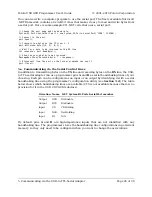
Using the Pololu SLO-scope Application
This application connects to the programmer, streams data from the SLO-scope, and
provides the basic functionality of a 10 or 20 kHz oscilloscope.
Pololu SLO-scope client for Windows.
Controls are available for setting the SLO-scope operating mode, adjusting the horizontal
and vertical scales, and configuring lines
A
and
B
as digital outputs.
To start capturing data, click the
Run
button in the upper right corner. If the horizontal scale
is such that it takes more than 200 ms of data to fill the lower SLO-scope pane, the data will
continuously stream across the pane. If the lower pane displays 200 ms of data or less, the
pane will draw all of its data at once when it has enough new data to warrant an update (or,
if triggering is enabled, when the trigger event is satisfied). In this latter time domain, you
can enable the persistence feature (check the Persistence checkbox) to cause the data on the
screen to fade out over time when the next update occurs. The Length parameter determines
how long it takes for the data to fade. The upper SLO-scope pane shows a summary of all of
the data currently stored in memory. This is approximately 10 seconds of data when running
at 10 kHz and 5 seconds of data when running at 20 kHz.
To review the captured data in detail, click the
Stop
button (in the same place that the
Run
previously occupied). When the SLO-scope is stopped, you can scroll through the data
stored in memory by clicking on the portion of the upper pane that you want to inspect or by
clicking and dragging the cursor in the lower pane to pan through the data more finely. You
can zoom in and out by changing the horizontal scale, and you can inspect the data in the
lower pane by hovering over it with your cursor. A purple rectangle highlights the portion of
the upper pane is visible in the lower pane.
You can adjust the vertical scaling of a channel’s data by changing its volts-per-division
parameter, and you can adjust the amount of data that is shown in the lower pane by
changing the SLO-scope’s milliseconds-per-division (horizontal scale) parameter.
Triggering can be used when horizontal scaling is 20 ms/div or less. You can trigger on rising
or falling edges of either channel A or channel B, and you can adjust the trigger level by
directly setting the value in millivolts or by dragging the trigger level scrollbar on the right
Pololu USB AVR Programmer User's Guide
© 2001–2010 Pololu Corporation
6. Measuring Voltages Using the SLO-scope
Page 30 of 36





















